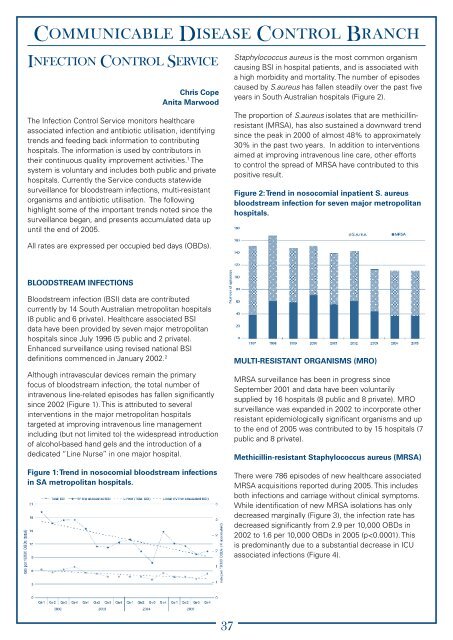Public Health and Communicable Diseases - SA Health - SA.Gov.au
Public Health and Communicable Diseases - SA Health - SA.Gov.au
Public Health and Communicable Diseases - SA Health - SA.Gov.au
Create successful ePaper yourself
Turn your PDF publications into a flip-book with our unique Google optimized e-Paper software.
<strong>Communicable</strong> Disease Control BranchInfection Control ServiceChris CopeAnita MarwoodThe Infection Control Service monitors healthcareassociated infection <strong>and</strong> antibiotic utilisation, identifyingtrends <strong>and</strong> feeding back information to contributinghospitals. The information is used by contributors intheir continuous quality improvement activities. 1 Thesystem is voluntary <strong>and</strong> includes both public <strong>and</strong> privatehospitals. Currently the Service conducts statewidesurveillance for bloodstream infections, multi-resistantorganisms <strong>and</strong> antibiotic utilisation. The followinghighlight some of the important trends noted since thesurveillance began, <strong>and</strong> presents accumulated data upuntil the end of 2005.All rates are expressed per occupied bed days (OBDs).Staphylococcus <strong>au</strong>reus is the most common organismc<strong>au</strong>sing BSI in hospital patients, <strong>and</strong> is associated witha high morbidity <strong>and</strong> mortality. The number of episodesc<strong>au</strong>sed by S.<strong>au</strong>reus has fallen steadily over the past fiveyears in South Australian hospitals (Figure 2).The proportion of S.<strong>au</strong>reus isolates that are methicillinresistant(MR<strong>SA</strong>), has also sustained a downward trendsince the peak in 2000 of almost 48% to approximately30% in the past two years. In addition to interventionsaimed at improving intravenous line care, other effortsto control the spread of MR<strong>SA</strong> have contributed to thispositive result.Figure 2: Trend in nosocomial inpatient S. <strong>au</strong>reusbloodstream infection for seven major metropolitanhospitals.BLOODSTREAM INFECTIONSBloodstream infection (BSI) data are contributedcurrently by 14 South Australian metropolitan hospitals(8 public <strong>and</strong> 6 private). <strong>Health</strong>care associated BSIdata have been provided by seven major metropolitanhospitals since July 1996 (5 public <strong>and</strong> 2 private).Enhanced surveillance using revised national BSIdefinitions commenced in January 2002. 2Although intravascular devices remain the primaryfocus of bloodstream infection, the total number ofintravenous line-related episodes has fallen significantlysince 2002 (Figure 1). This is attributed to severalinterventions in the major metropolitan hospitalstargeted at improving intravenous line managementincluding (but not limited to) the widespread introductionof alcohol-based h<strong>and</strong> gels <strong>and</strong> the introduction of adedicated “Line Nurse” in one major hospital.Figure 1: Trend in nosocomial bloodstream infectionsin <strong>SA</strong> metropolitan hospitals.MULTI-RESISTANT ORGANISMS (MRO)MR<strong>SA</strong> surveillance has been in progress sinceSeptember 2001 <strong>and</strong> data have been voluntarilysupplied by 16 hospitals (8 public <strong>and</strong> 8 private). MROsurveillance was exp<strong>and</strong>ed in 2002 to incorporate otherresistant epidemiologically significant organisms <strong>and</strong> upto the end of 2005 was contributed to by 15 hospitals (7public <strong>and</strong> 8 private).Methicillin-resistant Staphylococcus <strong>au</strong>reus (MR<strong>SA</strong>)There were 786 episodes of new healthcare associatedMR<strong>SA</strong> acquisitions reported during 2005. This includesboth infections <strong>and</strong> carriage without clinical symptoms.While identification of new MR<strong>SA</strong> isolations has onlydecreased marginally (Figure 3), the infection rate hasdecreased significantly from 2.9 per 10,000 OBDs in2002 to 1.6 per 10,000 OBDs in 2005 (p
















